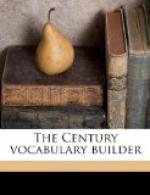You now know the original sense of the word and its central signification today. The two may be identical; they may be widely different; but through reflection or study of the entire definition you will establish some sort of connection between them. When you have done this, you have mastered the word. From the two meanings you can surmise the others, wherever and whenever encountered; for the others are but outgrowths and applications of them.
One warning will not be amiss. You must not suppose that the terms used in defining a word are its absolute synonyms, or may be substituted for it indiscriminately. You must develop a feeling for the limits of the word, so that you may perceive where its likeness to the other terms leaves off and its unlikeness begins. Thus if one of the terms employed in defining command is control, you must not assume that the two words are interchangeable; you must not say, for instance, that the captain controlled his men to present arms.
Such, abstractly stated, is the way to look up a word in the dictionary. Let us now take a concrete illustration. Starting with the word tension, let us ascertain what we can about it in the Century Dictionary and Cyclopedia. Our first quest is the original meaning. For this we consult the bracketed matter. There we meet the French, Spanish, Portuguese, and Italian kinsmen of the word, and learn that they are traceable to a common ancestor, the Latin tensio(n), which comes from the Latin verb tendere. The meaning of tensio(n) is given as “stretching,” that of tendere as “stretch,” “extend.” Thus we know of the original word that in form it closely resembles the modern word, and that in meaning it involves the idea of stretching.
What is the central meaning of the word today? To acquaint ourselves with this we must run through the definitions listed. Here (in condensed form) they are. (1) The act of stretching. (2) In mechanics, stress or the force by which something is pulled. (3) In physics, a constrained condition of the particles of bodies. (4) In statical electricity, surface-density. (5) Mental strain, stress, or application. (6) A strained state of any kind, as political or social. (7) An attachment to a sewing-machine for regulating the strain of the thread. Now of these definitions (2), (3), (4), and (7) are too highly specialized to conduct us, of themselves, into the highway of the word’s meaning. They bear out, however, the evidence of (1), (5), and (6), which have as their core the idea of stretching, or of the strain which stretching produces.
We must now lay the original meaning alongside the central meaning today, in order to draw our conclusions. We perceive that the two meanings correspond. Yet by prying into them we make out one marked difference between them. The original meaning is literal, the modern largely figurative. To be sure, the figure has been so long used that it is now scarcely felt as a figure; its force and definiteness have departed. Consequently we may speak of being on a tension without having in mind at all a comparison of our nervous system with a stretched garment, or with an outreaching arm, or with a tightly strung musical instrument, or with a taut rope.




